Coupling of Forest Carbon Densities with Landscape Patterns and Climate Change in the Lesser Khingan Mountains, Northeast China
Abstract
:1. Introduction
2. Materials and Methods
2.1. Study Area
2.2. Data Acquisition and Processing
2.2.1. Calculation of Carbon Density
- Continuous function model formulas of forest biomass conversion coefficients
| WA = Wr + Ws + Wb + Wf * | (1) | ||||
| Forest Types | Subitem | Formula | Forest Types | Subitem | Formula |
| Birch forest | root | Wr = (Dq/(−7.7814 + 5.2684 Dq)) V | Black birch forest | root | Wr = (Dq/(−11.7444 + 5.7857 Dq)) V |
| trunk | Ws = (H/(−0.7161 + 1.7316 H)) V | trunk | Ws = (Dq/(3.0469 + 1.3313 Dq)) V | ||
| branch | Wb = (H/(71.1504 + 2.3594 H)) V | branch | Wb = (Dq/(105.2694 − 1.7441 Dq))V | ||
| leaf | Wf = (Dq/(52.1765 + 31.5260 Dq)) V | leaf | Wf = (Dq/(−133.4280 + 40.7349 Dq)) V | ||
| Korean pine forest | root | Wr = (H/(−7.4947 + 5.4000 H)) V | Oak forest | root | Wr = 0.2709 Dq−0.0224 H−0.0124 V |
| trunk | Ws = (N/(369.6842 + 1.5593 N)) V | trunk | Ws = (Dq/(3.4101 + 1.1859 Dq)) V | ||
| branch | Wb = 0.1087 Dq0.1196 H−0.1086 V | branch | Wb = (Dq/(70.6539 + 0.2149 Dq)) V | ||
| leaf | Wf = 0.2835Dq−0.2446 H−0.2737 V | leaf | Wf = 0.0213 * Dq−0.0248 H0.2141 V | ||
| Mixed broadleaved forest | root | Wr = (H/(−6.0790 + 5.4717H)) V | Mixed coniferous forest | root | Wr = (Dq/(14.2890 + 4.8830 Dq)) V |
| trunk | Ws = 0.5193 Dq0.1529 H−0.0981 V | trunk | Ws = (Dq/(0.6756 + 2.1000 Dq)) V | ||
| branch | Wb = (Dq/(79.2051 + 1.2886 Dq)) V | branch | Wb = 0.0631 * Dq0.3538 H−0.2781 V | ||
| leaf | Wf = (Dq/(−84.3635 + 42.2363 Dq)) V | leaf | Wf = (Dq/(−156.9210 + 43.4676 Dq)) V | ||
| Larch forest | root | Wr = (Dq/(44.2954 + 1.1820 Dq)) V | Larch plantation | root | Wr = (Dq/(43.1398 + 3.0221 Dq)) V |
| trunk | Ws = 0.2638 * Dq0.6084 H−0.3052 V | trunk | Ws = (Dq/(11.8721 + 0.9735 Dq)) V | ||
| branch | Wb = 0.0893 Dq0.5372 H−0.5798 V | branch | Wb = (Dq/(−14.7782 + 14.9115 Dq)) V | ||
| leaf | Wf = (Dq/(−320.5650 + 69.0763 Dq)) V | leaf | Wf = (Dq/(−267.4450 + 57.5741 Dq)) V | ||
| Mixed broadleaf- conifer forest | root | Wr = (H/(−2.1908 + 5.6433 H)) V | Aspen forest | root | Wr = (Dq/(−7.7200 + 0.1178 Dq)) V |
| trunk | Ws = (Dq/(−1.3193 + 2.0249 Dq)) V | trunk | Ws = (H/(−2.5225 + 2.0046 H)) V | ||
| branch | Wb = (Dq/(58.0685 + 5.6768 Dq)) V | branch | Wb = (Dq/(107.0625 + 3.9071 Dq)) V | ||
| leaf | Wf = (Dq/(−507.2690 + 78.1762 Dq)) V | leaf | Wf = (Dq/(13.5491 + 49.5804 Dq)) V | ||
- 2.
- Carbon density calculation of shrubbery
- 3.
- Calculation of forest carbon density
2.2.2. Extraction of Landscape Pattern Index
2.2.3. Extraction of the Climate Index from the Forest Bureau
2.2.4. The Coupling Coordination Degree Model
3. Results
3.1. Results of Spatial Distribution of Forest Carbon Density
3.2. Results of the Moving-Window Method in Landscape Pattern Space Analysis
3.3. Results of Pearson Correlation Analysis for Screening Local Forest Climate Factors
3.4. Results of the Spatial Distribution of the Coupling Coordination Degree
4. Discussion
4.1. Spatial Distribution and Characteristic Analysis of Carbon Density Based on Different Stand Types
4.2. Spatial Characteristic Analysis of Landscape Patterns Based on the Moving-Window Method
4.3. Analysis of the Spatial Distribution Characteristics of the Coupling Coordination Degree
5. Conclusions
Author Contributions
Funding
Informed Consent Statement
Data Availability Statement
Conflicts of Interest
References
- Li, Q.; Han, Y.; Liu, X.; Ansari, U.; Cheng, Y.; Yan, C. Hydrate as a by-product in CO2 leakage during the long-term sub-seabed sequestration and its role in preventing further leakage. Env. Sci. Pollut. Res. 2022, 29, 77737–77754. [Google Scholar] [CrossRef]
- Dai, A. Increasing drought under global warming in observations and models. Nat. Clim. Chang. 2013, 3, 52–58. [Google Scholar] [CrossRef]
- Trenberth, K.E.; Dai, A.; Van Der Schrier, G.; Jones, P.D.; Barichivich, J.; Briffa, K.R.; Sheffield, J. Global warming and changes in drought. Nat. Clim. Chang. 2014, 4, 17–22. [Google Scholar] [CrossRef]
- Bennett, A.C.; McDowell, N.G.; Allen, C.D.; Anderson-Teixeira, K.J. Larger trees suffer most during drought in forests worldwide. Nat. Plants 2015, 1, 15139. [Google Scholar] [CrossRef]
- DeSoto, L.; Cailleret, M.; Sterck, F.; Jansen, S.; Kramer, K.; Robert, E.M.R.; Aakala, T.; Amoroso, M.M.; Bigler, C.; Camarero, J.J.; et al. Low growth resilience to drought is related to future mortality risk in trees. Nat. Commun. 2020, 11, 545. [Google Scholar] [CrossRef]
- Sterck, F.F.; Vos, M.A.; Hannula SE, S.; de Goede, S.S.; de Vries, W.W.; den Ouden, J.J.; Veen, C.G. Optimizing stand density for climate-smart forestry: A way forward towards resilient forests with enhanced carbon storage under extreme climate events. Soil. Biol. Biochem. 2021, 162, 108396. [Google Scholar] [CrossRef]
- Dixon, R.K.; Solomon, A.M.; Brown, S.; Houghton, R.A.; Trexier, M.C.; Wisniewski, J. Carbon Pools and Flux of Global Forest Ecosystems. Science 1994, 263, 185–190. [Google Scholar] [CrossRef]
- Wanlong, S.; Yowhan, S.; Baishuo, H.; Xuehua, L. An individual tree-based model for estimating regional and temporal carbon storage of Abies chensiensis forest ecosystem in the Qinling Mountains, China. Ecol. Model. 2023, 479, 110305. [Google Scholar] [CrossRef]
- Wang, F.; Xiao, Z.; Liu, X.; Ren, J.; Xing, T.; Li, Z.; Li, X.; Chen, Y. Strategic design of cellulose nanofibers@zeolitic imidazolate frameworks derived mesoporous carbon-supported nanoscale CoFe2O4/CoFe hybrid composition as trifunctional electrocatalyst for Zn-air battery and self-powered overall water-splitting. J. Power Sources 2022, 521, 230925. [Google Scholar] [CrossRef]
- Li, Q.; Wang, F.; Wang, Y.; Forson, K.; Cao, L.; Zhang, C.; Zhou, C.; Zhao, B.; Chen, J. Experimental investigation on the high-pressure sand suspension and adsorption capacity of guar gum fracturing fluid in low-permeability shale reservoirs: Factor analysis and mechanism disclosure. Env. Sci. Pollut. Res. 2022, 29, 53050–53062. [Google Scholar] [CrossRef]
- Sun, W.; Liu, X. Review on carbon storage estimation of forest ecosystem and applications in China. For. Ecosyst. 2020, 7, 4. [Google Scholar] [CrossRef]
- Smithwick, E.A.H.; Harmon, M.E.; Remillard, S.M.; Acker, S.A.; Franklin, J.F. Potential upper bounds of carbon stores in forests of the pacific northwest. Ecol. Appl. 2002, 12, 1303–1317. [Google Scholar] [CrossRef]
- Hudiburg, T.; Law, B.; Turner, D.P.; Campbell, J.; Donato, D.; Duane, M. Carbon dynamics of Oregon and Northern California forests and potential land-based carbon storage. Ecol. Appl. 2009, 19, 163–180. [Google Scholar] [CrossRef]
- Case, M.J.; Johnson, B.G.; Bartowitz, K.J.; Hudiburg, T.W. Forests of the future: Climate change impacts and implications for carbon storage in the Pacific Northwest, USA. For. Ecol. Manag. 2021, 482, 118886. [Google Scholar] [CrossRef]
- Tang, J.; Li, Y.; Cui, S.; Xu, L.; Ding, S.; Nie, W. Linking land-use change, landscape patterns, and ecosystem services in a coastal watershed of southeastern China. Glob. Ecol. Conserv. 2020, 23, e01177. [Google Scholar] [CrossRef]
- De Groot, R.; Brander, L.; Van Der Ploeg, S.; Costanza, R.; Bernard, F.; Braat, L.; Christie, M.; Crossman, N.; Ghermandi, A.; Hein, L.; et al. Global estimates of the value of ecosystems and their services in monetary units. Ecosyst. Serv. 2012, 1, 50–61. [Google Scholar] [CrossRef]
- Liu, M.; Xu, Y.; Hu, Y.; Li, C.; Sun, F.; Chen, T. A Century of the Evolution of the Urban Area in Shenyang, China. PLoS ONE 2014, 9, e98847. [Google Scholar] [CrossRef]
- Dadashpoor, H.; Azizi, P.; Moghadasi, M. Land use change, urbanization, and change in landscape pattern in a metropolitan area. Sci. Total Environ. 2019, 655, 707–719. [Google Scholar] [CrossRef]
- Wang, J.; Yang, X. A Hierarchical Approach to Forest Landscape Pattern Characterization. Environ. Manag. 2012, 49, 64–81. [Google Scholar] [CrossRef]
- Liang, X.; Guan, Q.; Clarke, K.C.; Liu, S.; Wang, B.; Yao, Y. Understanding the drivers of sustainable land expansion using a patch-generating land use simulation (PLUS) model: A case study in Wuhan, China. Comput. Environ. Urban. Syst. 2021, 85, 101569. [Google Scholar] [CrossRef]
- Yuan, X.H.; Li, J.P.; Li, J.J.; Zhang, P.F. The Coupling Network Modeling of Forest Landscape Plaques Based on Patch Edge Effects. Adv. Mater. Res. 2012, 546, 1080–1085. [Google Scholar] [CrossRef]
- Mina, M.; Messier, C.; Duveneck, M.; Fortin, M.; Aquilué, N. Network analysis can guide resilience-based management in forest landscapes under global change. Ecol. Appl. 2021, 31, e2221. [Google Scholar] [CrossRef]
- Tang, Y.; She, J.; Hu, B.; Wang, J. Coupling of Forest Carbon Density and Landscape Pattern Index in Haikou. J. Northwest For. Univ. 2020, 35, 168–175. [Google Scholar]
- Harris, N.; Gibbs, D.; Baccini, A.; Birdsey, R.; de Bruin, S.; Farina, M.; Fatoyinbo, L.; Hansen, M.; Herold, M.; Houghton, R.; et al. Global maps of twenty-first century forest carbon fluxes. Nat. Clim. Chang. 2021, 11, 234–240. [Google Scholar] [CrossRef]
- Ali, A.; Ashraf, M.I.; Gulzar, S.; Akmal, M. Estimation of forest carbon stocks in temperate and subtropical mountain systems of Pakistan: Implications for REDD+ and climate change mitigation. Env. Monit. Assess. 2020, 192, 198. [Google Scholar] [CrossRef]
- He, X.; Lei, X.; Zeng, W.; Feng, L.; Zhou, C.; Wu, B. Quantifying the Effects of Stand and Climate Variables on Biomass of Larch Plantations Using Random Forests and National Forest Inventory Data in North and Northeast China. Sustainability 2022, 14, 5580. [Google Scholar] [CrossRef]
- Cherchi, A.; Fogli, P.G.; Lovato, T.; Peano, D.; Iovino, D.; Gualdi, S.; Masina, S.; Scoccimarro, E.; Materia, S.; Bellucci, A.; et al. Global Mean Climate and Main Patterns of Variability in the CMCC-CM2 Coupled Model. J. Adv. Model. Earth Syst. 2019, 11, 185–209. [Google Scholar] [CrossRef]
- Vieilledent, G.; Gardi, O.; Grinand, C.; Burren, C.; Andriamanjato, M.; Camara, C.; Gardner, C.J.; Glass, L.; Rasolohery, A.; Rakoto Ratsimba, H.; et al. Bioclimatic envelope models predict a decrease in tropical forest carbon stocks with climate change in Madagascar. J. Ecol. 2016, 104, 703–715. [Google Scholar] [CrossRef]
- Liu, L. The Research on Forest Landscape Patterns and Spatial-temporal Evolution of Carbon Stock in Wuzhishan City. Doctoral Thesis, University of Central South University of Forestry and Technology, Changsha, China, 2015. [Google Scholar]
- Dong, L. Developing Individual and Stand-Level Biomass Equations in Northeast China forest Area. Doctoral Thesis, University of Northeast Forestry University, Harbin, China, 2015. [Google Scholar]
- Jia, W. Forest Biomass and Carbon Storage of Various Forest Types in the Northeast Forest Region; Heilongjiang Scienc & Technology Press: Harbin, China, 2014; p. 7. [Google Scholar]
- Fang, J.; Chen, A. Dynamic Forest Biomass Carbon Pools in China and Their Significance. Bull. Bot. 2001, 43, 967–973. [Google Scholar]
- Wei, M. Carbon Storage and Economic Assessment Ofurban Forest Vegetation-A Case Study of Wuzhishan City. Master’s Thesis, University of Central South University of Forestry and Technology, Changsha, China, 2014. [Google Scholar]
- Grimm, N.B.; Faeth, S.H.; Golubiewski, N.E.; Redman, C.L.; Wu, J.; Bai, X.; Briggs, J.M. Global Change and the Ecology of Cities. Science 2008, 319, 756–760. [Google Scholar] [CrossRef]
- Liao, Z.B. Quantitative Assessment of Coordinated Growth between Environment and Economy and Its Classfication System. Guang Zhou Huan Jing Ke Xue 1996, 11, 76–82. [Google Scholar]
- Jiang, L.; Bai, L.; Wu, Y.M. Coupling and Coordinating Degrees of Provincial Economy, Resources and Environment in China. J. Nat. Resour. 2017, 32, 788–799. [Google Scholar]
- Liu, C. Common Mistakes in Coupling Degree Calculation. J. Huaiyin Teach. Coll. 2017, 16, 18–22. [Google Scholar]
- Jun-Fang, Z.; Xiao-Dong, Y.; Gen-Suo, J. Simulation of carbon stocks of forest ecosystems in Northeast China from 1981 to 2002. Chin. J. Appl. Ecol. 2009, 20, 241–249. [Google Scholar]
- Min, Z.; Guangsheng, Z. Carbon Storage of Forest Vegetation and its Relationship with Climatic Factors. Sci. Geogr. Sin. 2004, 24, 50–54. [Google Scholar]
- Zhang, X.; Jia, W.; Sun, Y.; Wang, F.; Miu, Y. Simulation of Spatial and Temporal Distribution of Forest Carbon Stocks in Long Time Series—Based on Remote Sensing and Deep Learning. Forests 2023, 14, 483. [Google Scholar] [CrossRef]
- Watson, J.E.M.; Evans, T.; Venter, O.; Williams, B.; Tulloch, A.; Stewart, C.; Thompson, I.; Ray, J.C.; Murray, K.; Salazar, A.; et al. The exceptional value of intact forest ecosystems. Nat. Ecol. Evol. 2018, 2, 599–610. [Google Scholar] [CrossRef]
- Svensson, J.; Bubnicki, J.W.; Jonsson, B.G.; Andersson, J.; Mikusiński, G. Conservation significance of intact forest landscapes in the Scandinavian Mountains Green Belt. Landsc. Ecol. 2020, 35, 2113–2131. [Google Scholar] [CrossRef]
- Vanderley-Silva, I.; Valente, R.A. Functional connectivity supported by forest conservation in urban sprawl landscape in São Paulo, Brazil. GeoJournal 2023, 88, 3011–3028. [Google Scholar] [CrossRef]
- Qi, H.; He, P. Analysis of Climate Change Characteristics of Temperature and Precipitation in Yichun Region in the Last 60 Years. Environ. Prot. Circ. Econ. 2021, 41, 70–72. [Google Scholar]
- Zhou, L.; Wang, S.; Kindermann, G.; Yu, G.; Huang, M.; Mickler, R.; Kraxner, F.; Shi, H.; Gong, Y. Carbon dynamics in woody biomass of forest ecosystem in China with forest management practices under future climate change and rising CO2 concentration. Chin. Geogr. Sci. 2013, 23, 519–536. [Google Scholar] [CrossRef]
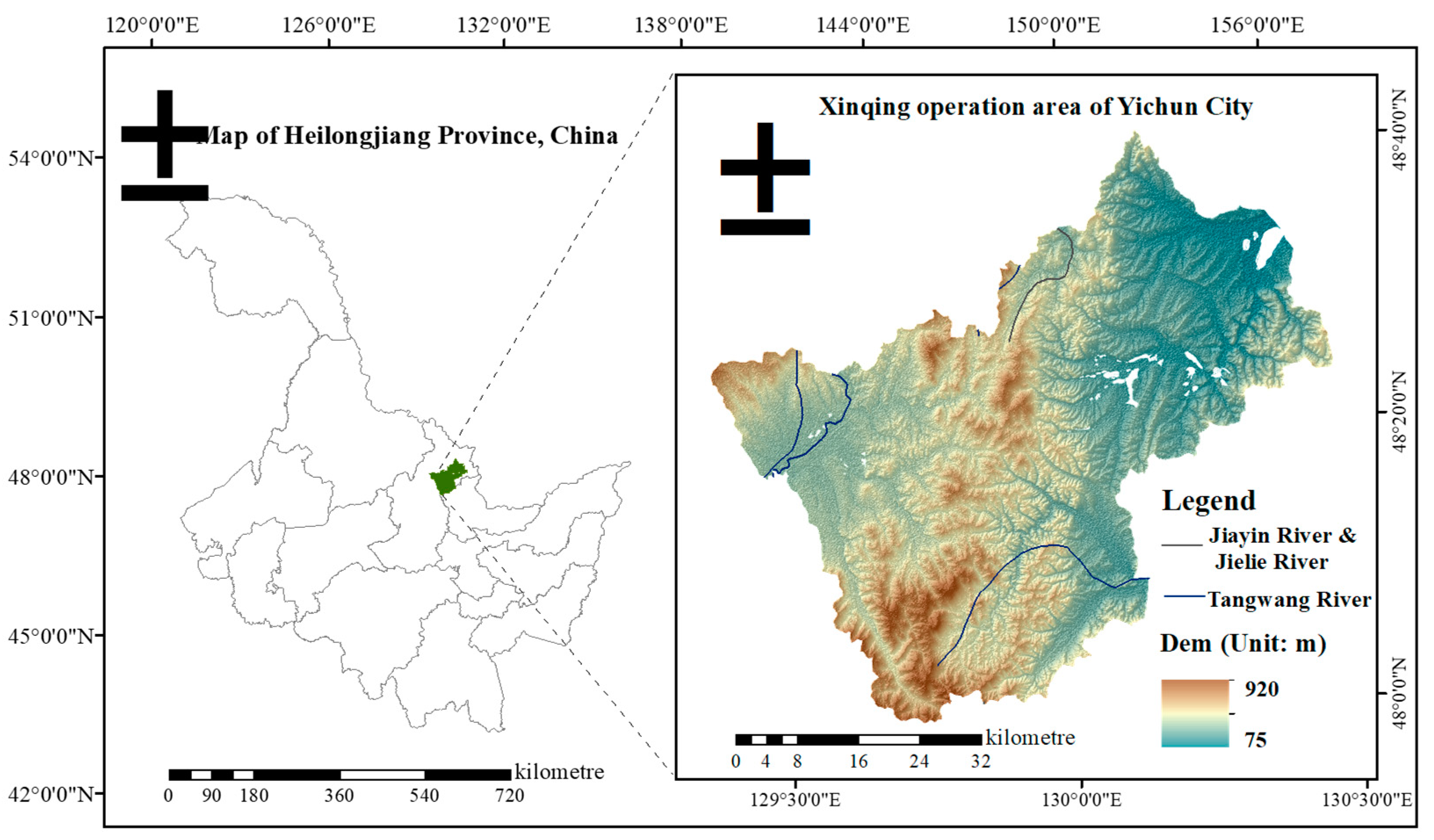
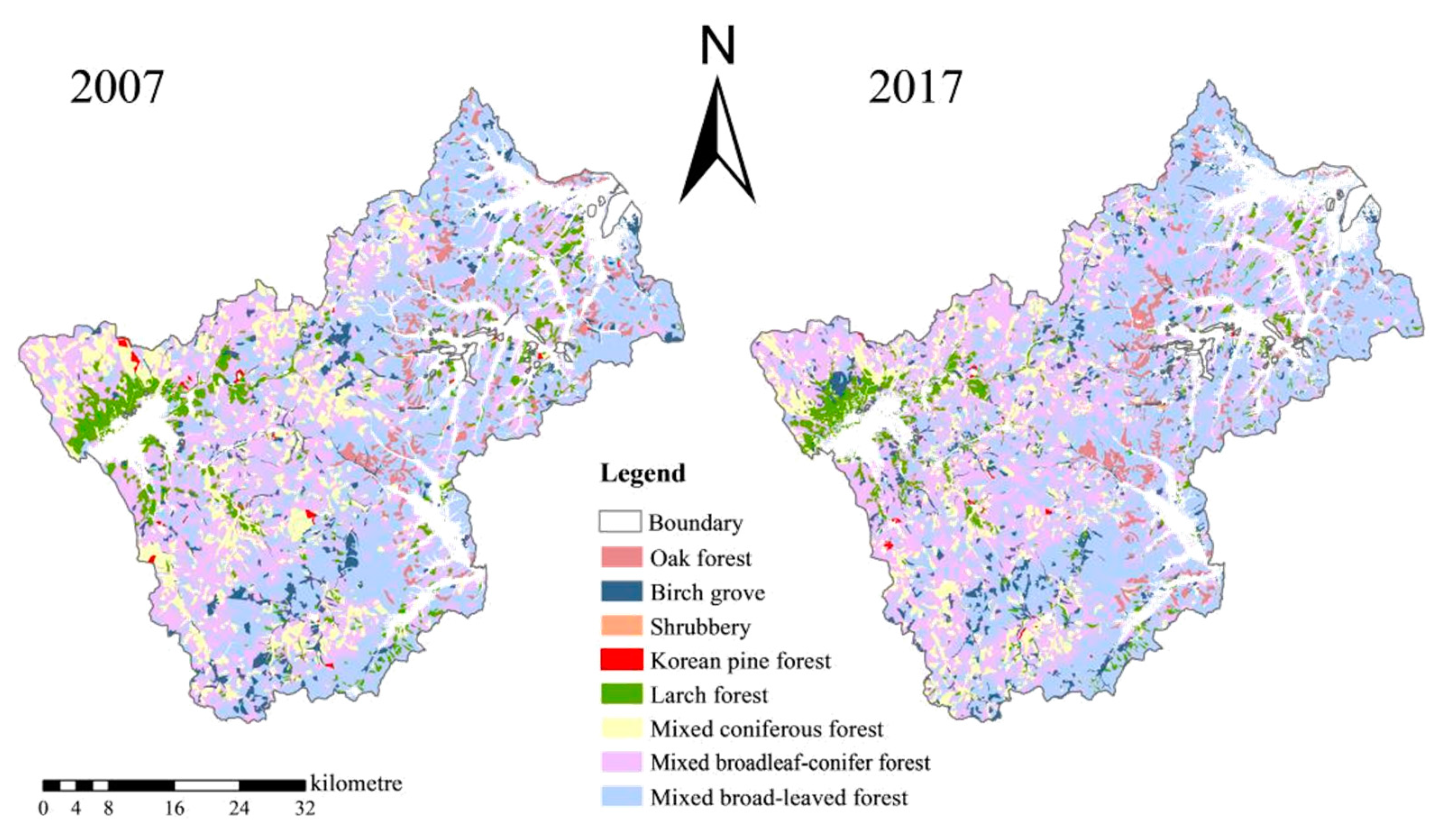
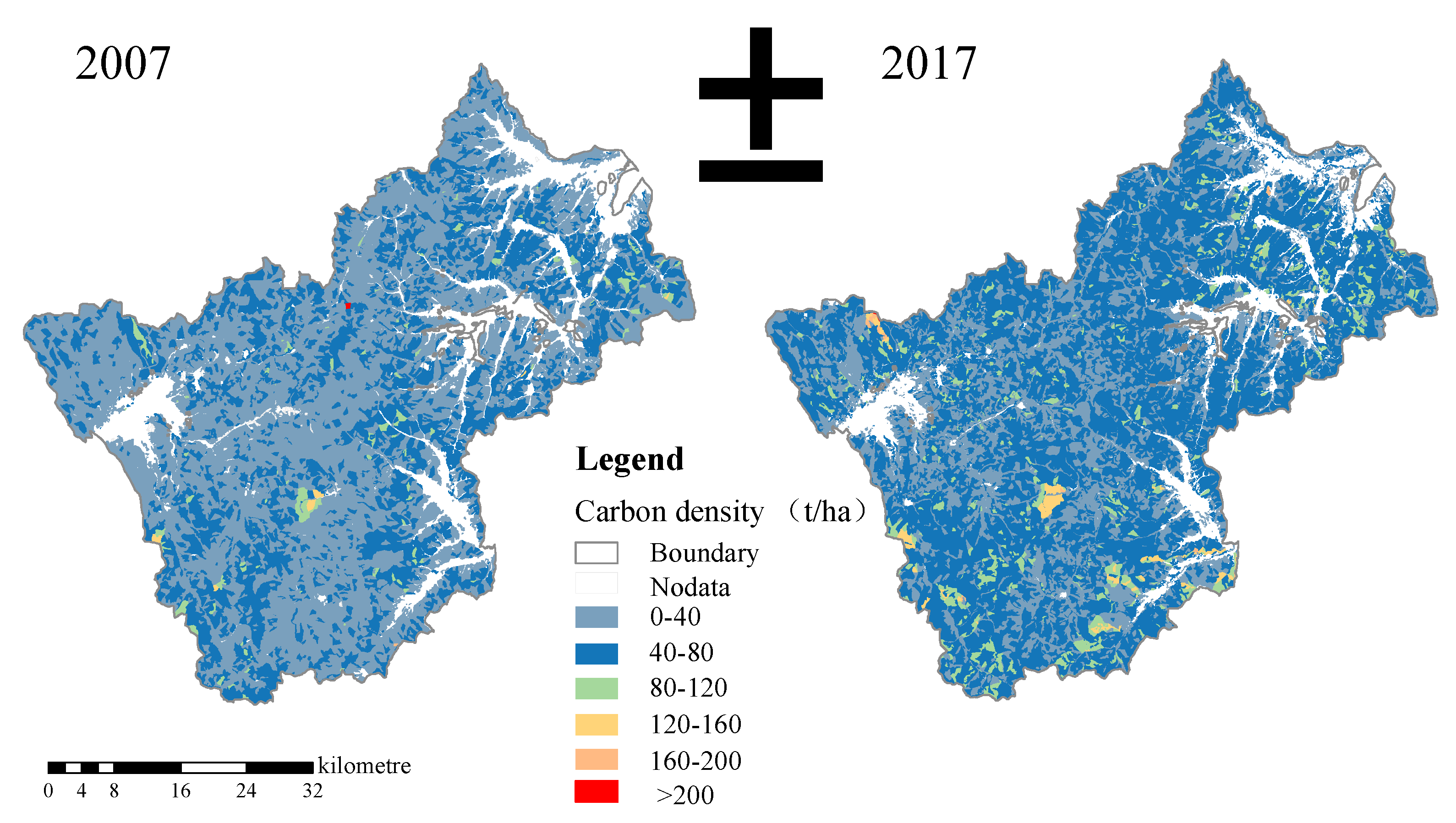
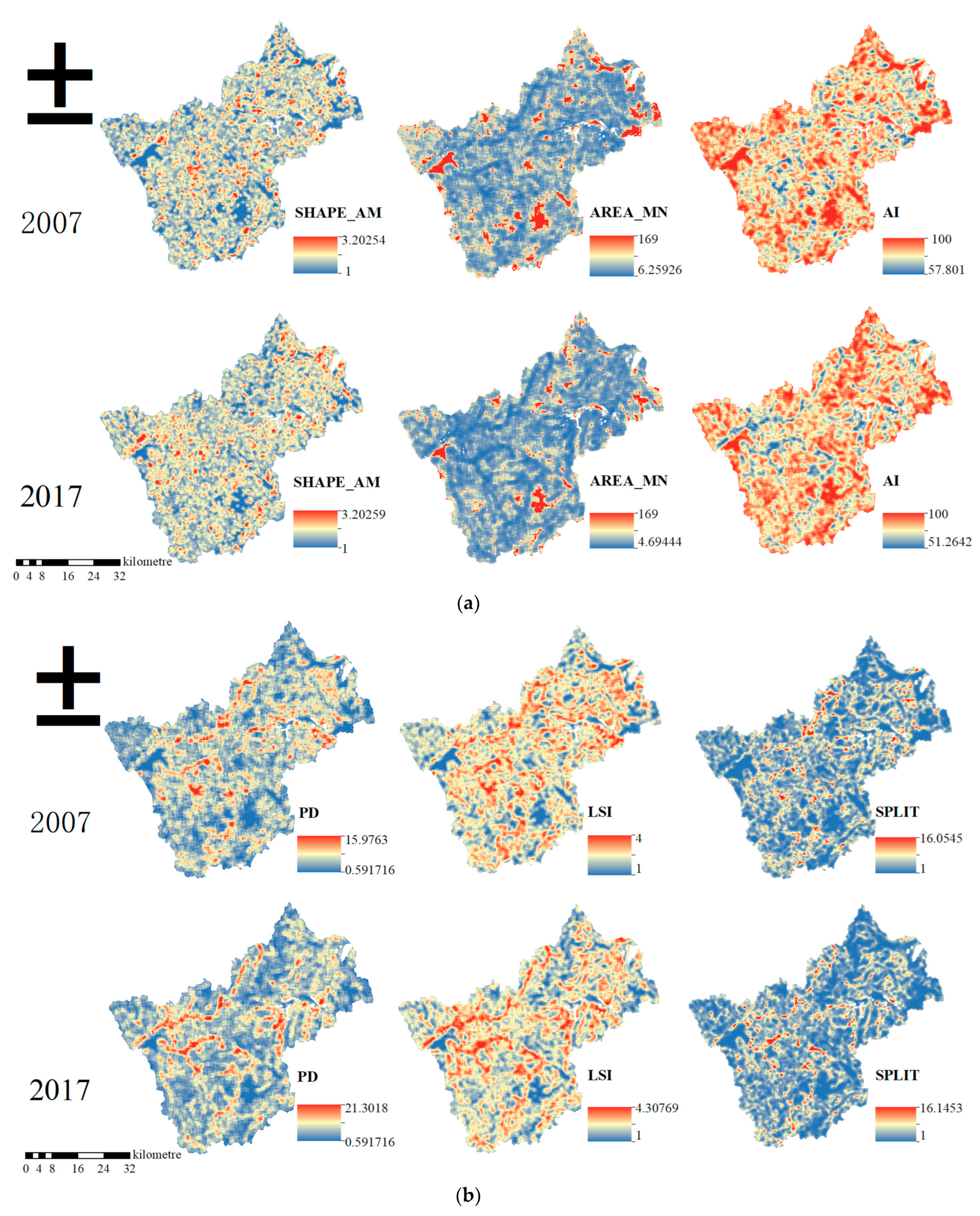
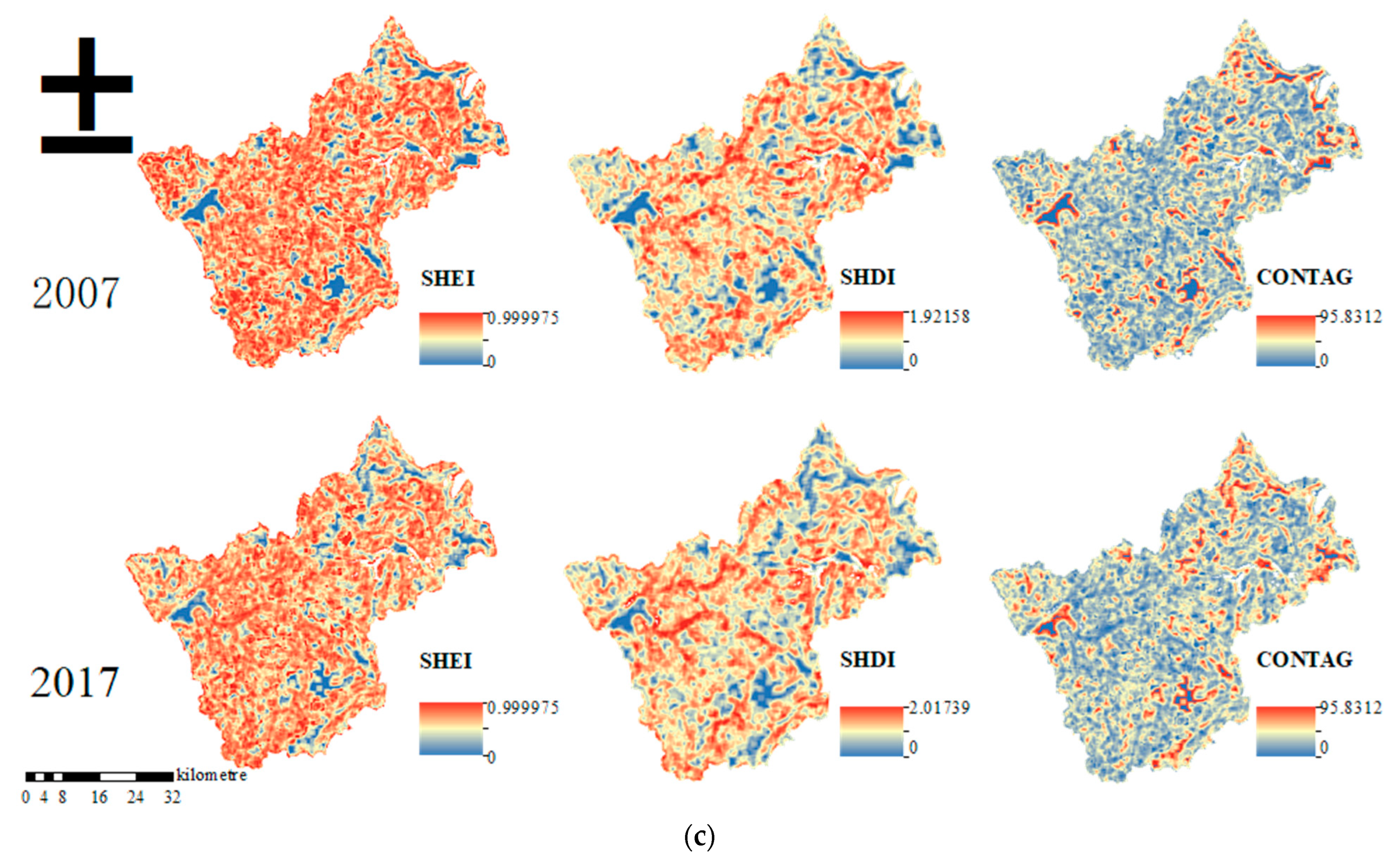
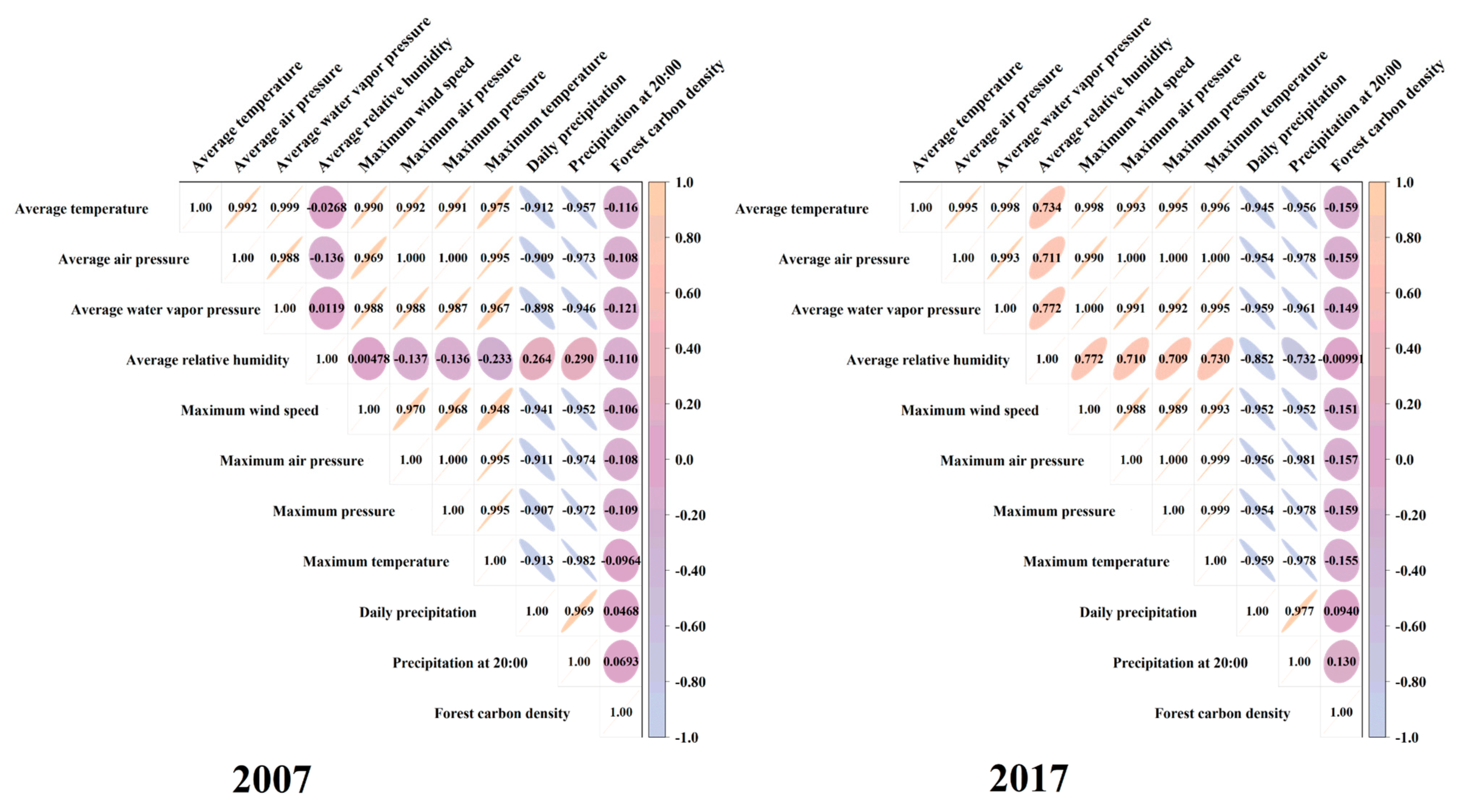
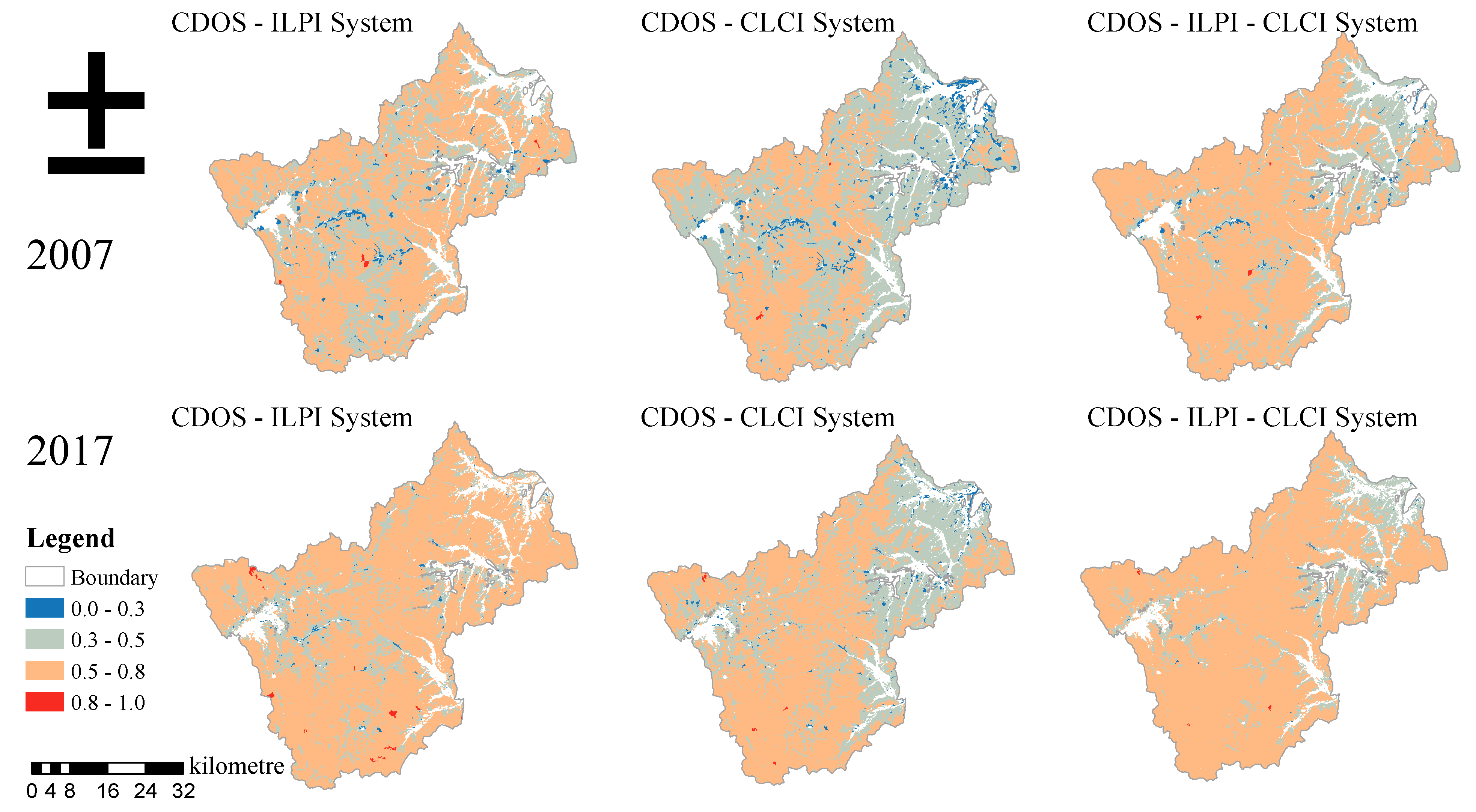
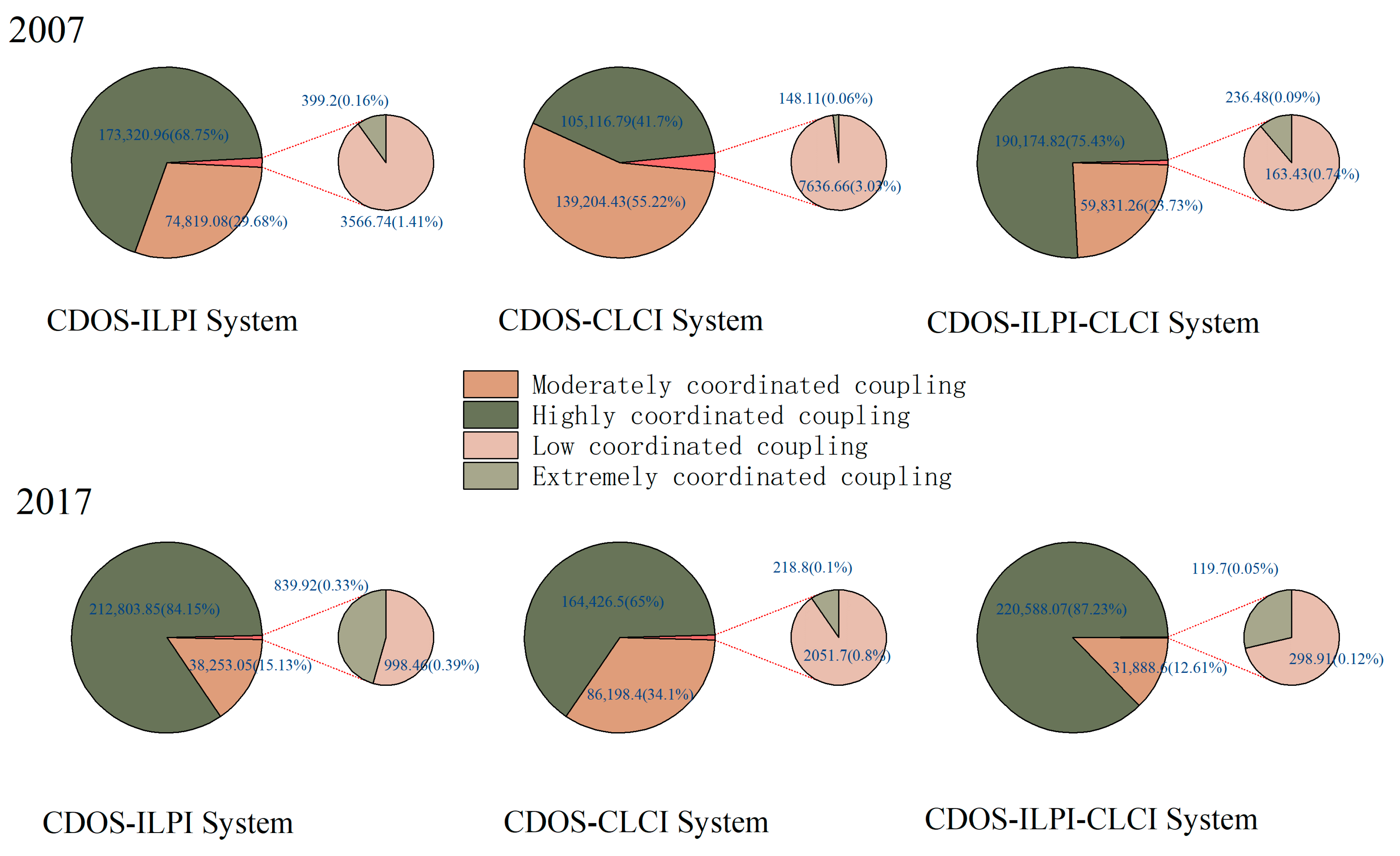
| Forest Types | Average Carbon Content * | Stand Type | Average Carbon Content * |
|---|---|---|---|
| Spruce | 0.4804 | Fir | 0.4805 |
| Oak | 0.453 | Aspen | 0.445 |
| Black birch | 0.4562 | White birch | 0.4656 |
| Red pine plantation | 0.4809 | Natural red pine | 0.4881 |
| Larch plantation | 0.4674 | Natural larch | 0.4742 |
| Mixed broadleaved forest | 0.453 | Mixed coniferous forest | 0.4802 |
| Mixed broadleaf–conifer forest | 0.458 |
| D * | Coupling Coordination Degree Level |
|---|---|
| 0 < D ≤ 0.3 | Low coordinated coupling |
| 0.3<D ≤ 0.5 | Moderately coordinated coupling |
| 0.5<D ≤ 0.8 | Highly coordinated coupling |
| 0.8<D ≤ 1 | Extremely coordinated coupling |
| A Given Year | Sum of Squares | df | Mean Square | F | Significance | |
|---|---|---|---|---|---|---|
| Carbon density | 2007 | 256140.464 | 7 | 36591.495 | 119.277 | 0 |
| 2017 | 432826.346 | 7 | 61832.335 | 151.164 | 0 |
| Forest Types | Area (hm2) | Specific Gravity | Dynamic Change (K, %) | Carbon Density (t/ha) | |||
|---|---|---|---|---|---|---|---|
| 2007 | 2017 | 2007 | 2017 | 2007 | 2017 | ||
| Korean pine forest | 726.04 | 322.52 | 0.29% | 0.13% | −5.56% | 68.8 | 84.23 |
| Larch forest | 16,510.21 | 12,106.51 | 6.55% | 4.79% | −2.67% | 30.7 | 53.03 |
| Oak forest | 9425.04 | 9231.42 | 3.74% | 3.65% | −0.21% | 52.2 | 63.17 |
| Birch grove | 12,702.61 | 13,989.59 | 5.04% | 5.53% | 1.01% | 29.62 | 42.41 |
| Mixed broadleaved forest | 104,112.46 | 111,626.61 | 41.30% | 44.14% | 0.72% | 38.29 | 51.84 |
| Mixed coniferous forest | 31,798.77 | 24,707.38 | 12.61% | 9.77% | −2.23% | 35.24 | 48.19 |
| Mixed forest | 76,647.44 | 80,829.05 | 30.40% | 31.96% | 0.55% | 33.38 | 47.13 |
| Shrubbery | 183.42 | 82.2 | 0.07% | 0.03% | −5.52% | 9.84 | 9.84 |
| Total | 252,105.99 | 252,895.28 | 100.00% | 100.00% | 36.1 | 49.95 | |
| Index | Weights | Index | Weights | Index | Weights | |||
|---|---|---|---|---|---|---|---|---|
| 2007 | 2017 | 2007 | 2017 | 2007 | 2017 | |||
| SPLIT | 0.0820 | 0.0806 | SHAPE_AM | 0.1370 | 0.1261 | CONTAG | 0.1005 | 0.1109 |
| SHEI | 0.0972 | 0.0988 | PD | 0.0941 | 0.0981 | AI | 0.1464 | 0.1392 |
| SHDI | 0.1029 | 0.1071 | LSI | 0.1435 | 0.1386 | AREA_MN | 0.0963 | 0.1006 |
| Index | Average Air Pressure | Maximum Air Pressure | Average Temperature | Average Water Vapor Pressure | Maximum Temperature | Maximum Wind Speed | Precipitation at 20:00 | |
|---|---|---|---|---|---|---|---|---|
| Weights | 2007 | 0.1439 | 0.1438 | 0.1436 | 0.1431 | 0.1428 | 0.1418 | 0.1410 |
| 2017 | 0.1435 | 0.1435 | 0.1432 | 0.1432 | 0.1436 | 0.1428 | 0.1403 | |
Disclaimer/Publisher’s Note: The statements, opinions and data contained in all publications are solely those of the individual author(s) and contributor(s) and not of MDPI and/or the editor(s). MDPI and/or the editor(s) disclaim responsibility for any injury to people or property resulting from any ideas, methods, instructions or products referred to in the content. |
© 2023 by the authors. Licensee MDPI, Basel, Switzerland. This article is an open access article distributed under the terms and conditions of the Creative Commons Attribution (CC BY) license (https://creativecommons.org/licenses/by/4.0/).
Share and Cite
Wang, X.; Sun, Y.; Jia, W.; Wang, H.; Zhu, W. Coupling of Forest Carbon Densities with Landscape Patterns and Climate Change in the Lesser Khingan Mountains, Northeast China. Sustainability 2023, 15, 14981. https://doi.org/10.3390/su152014981
Wang X, Sun Y, Jia W, Wang H, Zhu W. Coupling of Forest Carbon Densities with Landscape Patterns and Climate Change in the Lesser Khingan Mountains, Northeast China. Sustainability. 2023; 15(20):14981. https://doi.org/10.3390/su152014981
Chicago/Turabian StyleWang, Xinghui, Yuman Sun, Weiwei Jia, Hezhi Wang, and Wancai Zhu. 2023. "Coupling of Forest Carbon Densities with Landscape Patterns and Climate Change in the Lesser Khingan Mountains, Northeast China" Sustainability 15, no. 20: 14981. https://doi.org/10.3390/su152014981





